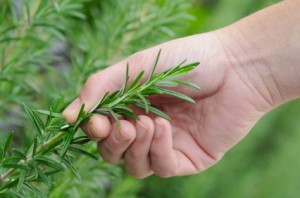
“There’s rosemary that’s for remembrance. Pray, you love, remember.” ~ Hamlet
Rosemary is one of my favorite herbs, mostly just because. I rarely cook with it, but love its scent and the wealth of history behind it. Known as the herb of remembrance from the time of ancient Greece, it appears in that immoral verse by Shakespeare. My fascination with herbs plays a significant role in my historical/light paranormal romance Somewhere My Love, as does Hamlet, for that matter. I always wanted to write a murder mystery with a focus on herbs and parallels to a Shakespearean play, and so I did.
A Modern Herbal by Maud Grieve, a wonderful source of herbal lore as well as practical information on the medicinal uses and growing requirements for a myriad of plants, is an invaluable guide. I have volumes one and two of Ms. Grieve’s work and can easily lose myself in their pages. She refers to her herbal as modern, and in comparison to the ancient herbalists it is, but A Modern Herbal is charmingly quaint and published in the early 20th century.
Regarding Rosemary, she says,
The Ancients were well acquainted with the shrub, which had a reputation for strengthening the memory. On this account it became the emblem of fidelity for lovers. It holds a special position among herbs from the symbolism attached to it. Not only was it used at weddings, but also at funerals, for decking churches and banqueting halls at festivals, as incense in religious ceremonies, and in magical spells.
At weddings, it was entwined in the wreath worn by the bride, being first dipped into scented water. Anne of Cleves, we are told, wore such a wreath at her wedding. A Rosemary branch, richly gilded and tied with silken ribands of all colours, was also presented to wedding guests, as a symbol of love and loyalty. Together with an orange stuck with cloves it was given as a New Year‘s gift…
In early times, Rosemary was freely cultivated in kitchen gardens and came to represent the dominant influence of the house mistress ‘Where Rosemary flourished, the woman ruled.’
The Treasury of Botany says:
‘There is a vulgar belief in Gloucestershire and other counties, that Rosemary will not grow well unless where the mistress is “master”; and so touchy are some of the lords of creation upon this point, that we have more than once had reason to suspect them of privately injuring a growing rosemary in order to destroy this evidence of their want of authority.’
Rosemary was one of the cordial herbs used to flavour ale and wine. It was also used in Christmas decoration.
“Down with the rosemary and so,
Down with the baies and mistletoe,
Down with the holly, ivie all
Wherewith ye deck the Christmas Hall.”
Although an herb, rosemary is often shaped into lovely miniature Christmas trees. The plant is well suited for this purpose as its essential oils produce a scent similar to pine trees and it has a natural evergreen shape and needle-like leaves.
If you purchase a rosemary plant whether as a Christmas tree or for your indoor herb garden, remember it needs good light and moderate watering. Allow the soil to dry before re-watering to avoid root rot. The most common cause of death for potted rosemary is over watering. In spring transfer your rosemary to a clay pot. The clay will help wick excess water out of the soil. Fertilize monthly to maintain health. To this advice I add that you can also kill them by allowing the plant to dry out, so don’t do that either.
Because rosemary is native to the hot, dry hills of the Mediterranean, growing it indoors can be a problem. You may find you get more dense vigorous growth if it is kept outside during most of the year. Trim the plant periodically to preserve the Christmas tree shape.



No comments:
Post a Comment